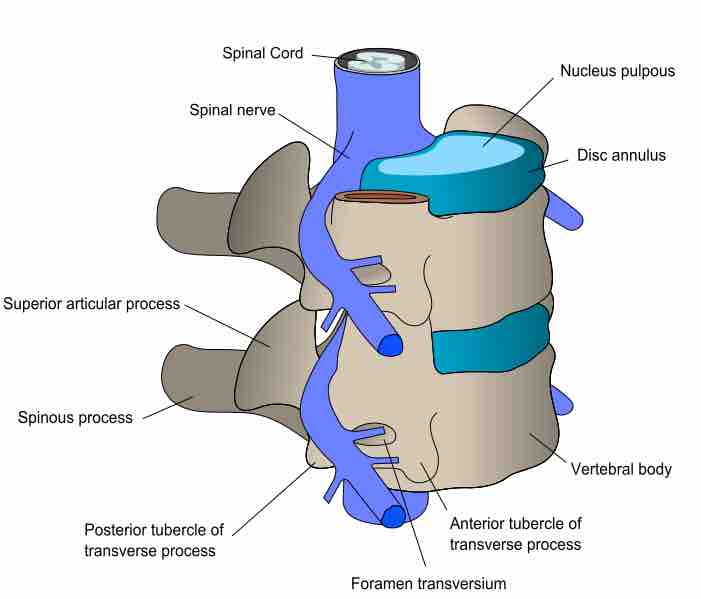Number of Vertebrae
In human anatomy, the vertebral column (backbone or spine) usually consists of 24 articulating vertebrae and nine fused vertebrae in the sacrum and the coccyx. Situated in the dorsal aspect of the torso and separated by intervertebral discs, it houses and protects the spinal cord in its spinal canal. There are normally 33 vertebrae in humans, including the five that are fused to form the sacrum, the four coccygeal bones that form the tailbone, and the others separated by intervertebral discs. The upper three regions comprise the remaining 24, and are grouped as cervical (seven vertebrae), thoracic (12 vertebrae) and lumbar (five vertebrae).
Vertebral Column
The sections of the vertebral column.
Vertebral Shape
A typical vertebra consists of the vertebral body and vertebral arch. These parts together enclose the vertebral foramen that contains the spinal cord. The vertebral arch is formed by a pair of pedicles and a pair of laminae. Two transverse processes and one spinous process are posterior to (behind) the vertebral body. The spinous process projects toward the posterior direction, while one transverse process projects to the left and the other to the right. The spinous processes of the cervical and lumbar regions can be felt through the skin. Facet joints are located above and below each vertebra. These restrict the range of movement. Between each pair of vertebrae are two small openings called intervertebral foramina through which the spinal nerves exit.

Vertebrae
Oblique view of cervical vertebrae.
Vertebral Curvature
When viewed laterally, the vertebral column presents several curves corresponding to the different regions of the column: cervical, thoracic, lumbar, and pelvic.
Cervical and Thoracic Curves
The cervical curve convexes forward and begins at the apex of the odontoid (tooth-like) process. It ends at the middle of the second thoracic vertebra. The thoracic curve convexes dorsally, begins at the middle of the second thoracic vertebra, and ends at the middle of the 12th thoracic vertebra.
Lumbar Curve
The lumbar curve, which is more pronounced in women than in men, begins at the middle of the last thoracic vertebra and ends at the sacrovertebral angle. It is convex anteriorly with the lower three vertebrae much more convex than the upper two. This curve is described as a lordotic curve. The pelvic curve begins at the sacrovertebral articulation and ends at the point of the coccyx; its concavity is directed downward and forward.
Primary and Secondary Curves
The thoracic and sacral curvatures are termed primary curves because they are present in the fetus and remain the same in the adult. As the child grows, lifts the head, and begins to assume an upright position, the secondary curves (cervical and lumbar) develop. The cervical curve forms when the infant is able to hold up his or her head (at three or four months) and sit upright (at nine months). The lumbar curve forms between twelve to eighteen months when the child begins to walk.